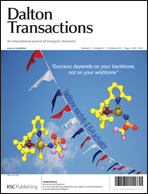The n = 1 Ruddlesden–Popper (RP) phases LaSrM0.5Ru0.5O4±δ (M = Co, Ni and Zn) have been prepared by solid state reactions and structurally characterized by powder X-ray and electron diffraction. All the samples adopt the tetragonal I4/mmm space group with random M and Ru cation occupation on the B-sites. The potential causes of no cation ordering are discussed. A combined analysis of the tolerance factors, the distortion of the octahedral coordination of M and Ru cations and the magnetic interactions between M and Ru cations provide a better understanding for forming a phase with 3D cation ordering on the B-sites in the n = 1 RP phases. The investigation of XPS spectra suggests that the transition element species exist as mixed ion pairs, Ru(4−δ)+–Ru4+ ↔ Co2+–Co3+ in LaSrCo0.5Ru0.5O4, and Ru4+–Ru(4+δ)+ ↔ Ni+–Ni2+ in LaSrNi0.5Ru0.5O4, which is consistent with cation disorder over the B sites. LaSrCo0.5Ru0.5O4 shows a weakly ferromagnetic behaviour below 50 K; LaSrNi0.5Ru0.5O4 is evidenced by the presence of long-range magnetic ordering at a Néel temperature of 125 K, and LaSrZn0.5Ru0.5O4 exhibits a paramagnetic behaviour down to 5 K. Due to atomic disorder, Ru4d, O2p covalent coupling is weakened, strengthening the intraatomic spin–spin coupling among the π* electrons. Charge transfer between Ru and Co or Ru and Ni, as well as the increasing overlap of both nearest-neighbour and next-nearest-neighbour Ru 4d electrons due to atomic disorder, favour the formation of ferromagnetic interactions. Although antiferromagnetism is dominant, particularly in LaSrNi0.5Ru0.5O4, ferromagnetic interactions are stronger in the title compounds than in the related La2MRuO6 (M = Co, Ni) double perovskites where the B-site cations are ordered.

You have access to this article
 Please wait while we load your content...
Something went wrong. Try again?
Please wait while we load your content...
Something went wrong. Try again?


 Please wait while we load your content...
Please wait while we load your content...